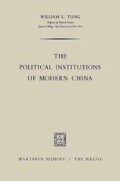Abstract
The Chinese People’s Political Consultative Conference (CPPCC), held in Peking from September 21 to 30, 1949, served as a constituent body of the People’s Republic for the creation of the Central People’s Government and the enactment of the Common Program. This Common Program and other fundamental laws adopted by the Conference constituted, in effect, a provisional constitution during the transitional period of 1949–1954. The CPPCC was claimed by the Communists to be “the organization of the democratic united front of the entire Chinese people,” composed of “all democratic classes and all nationalities throughout China,” for the establishment of “the unity of all democratic parties and groups and people’s organizations.”
Access this chapter
Tax calculation will be finalised at checkout
Purchases are for personal use only
Preview
Unable to display preview. Download preview PDF.
References
Art. 1 of the Organic Law of the Chinese People’s Political Consultative Conference, September 29, 1949. Its English text can be found in Albert P. Blaustein, Fundamental Legal Documents of Communist China, pp. 96–103.
See the Organic Law of the CPPCC, Arts. 4, 5.
Arts. 6, 7.
Ibid., Arts. 13, 14.
For further details of the organization of the CPPCC, see Arts. 8–20.
Their English texts can be found in Albert P. Blaustein, op. cit., pp. 34–53, 96–103, and 104–114 respectively.
The Common Program of the CPPCC, Art. 1.
Ibid., Art. 3.
Art. 1 of the Organic Law of the Central People’s Government.
See the Common Program, Arts. 3–6, 19.
Ibid., Art. 7.
Art. 8.
Art. 18.
For details, see Arts. 26–40.
Arts. 20–24.
Arts. 41–49.
For the number and names of the national minorities in China and their geographical distribution, see Ch. VII, Sec. 4, on self-determination of national minorities.
Arts. 50–53.
Arts. 54–60.
Arts. 12–20.
The following is an institutional description of the state organs of the Central People’s Government. For the chronological development of Communist control over the Mainland during the period of 1949–1954, see Richard L. Walker, China under Communism*, pp. 1–24.
The Organic Law of the Central People’s Government of 1949, Arts. 1–5.
Ibid., Art. 31.
The schedule of the Council meetings was flexible. During the five-year period of its existence, the Council held one meeting approximately every fifty-two days.
The Organic Law of the Central People’ s Government, Arts. 6, 8, 9, 10, 11.
Ibid., Art. 7.
Arts. 13, 14, 16, 17.
Arts. 15, 17.
Art. 18.
Arts. 13, 21, 22.
See S. B. Thomas, Government and Administration in Communist China*, p. 32.
Arts. 23–25.
Ch’eng, a former Nationalist general, went over to the Communists in 1949.
Arts. 26–30.
The English texts of the Agrarian Reform Law and other relevant documents can be found in a booklet under the title, The Agrarian Reform Law of the People’s Republic of China (Peking: Foreign Languages Press, 1959).
Most of these laws and regulations were printed in separate pamphlets. Their English texts can be found in Albert P. Blaustein, op. cit. (1962).
China Digest (Hongkong), December 14, 1949, p. 28.
As early as the middle of 1948, a people’s government was set up in the “liberated areas” of North China. On August 27, 1949, another people’s government was formed in the Northeast. Thus these two areas had already set up regional governments even before the inauguration of the Central People’s Government on October I, 1949.
Its text can be found in Current Background (Hongkong), No. 170. April 8, 1952.
New China News Agency (Peking), November 17, 1952.
Art. 14 of the Common Program.
The English texts can be found in the Research Project on the Chinese Communist Party Line (Russia-Research Center, Harvard University, Cambridge, Mass.), Docs. 1 and 4*.
China Monthly Review (Shanghai), December 1950, p. 118. For further details, see S. B. Thomas, op. cit., pp. 86–94.
See Ch. VII, Sec. 4, on self-determination.
Arts. 50–53 of the Common Program.
Liu Shao-ch’i, Report on the Draft Constitution of the People’s Republic of China*, p. 3.
Ibid., p. 19.
The English text of this Law together with an explanation was issued in a pamphlet form by the Foreign Languages Press, Peking 1953. The term, “National People’s Congress,” is sometimes translated as “The All-China People’s Congress.”
Arts. 3, 20–23, 25. The procedures for the election of deputies under categories (4) and (5) were left to the discretion of the Government.
All the Laws were adopted on September 21, 1954, with the exception of number (1) which was passed one day earlier. The laws under (2) and (5) were amended at the second session of the National People’s Congress on July 30, 1955. For their English texts, see Albert P. Blaustein, op. cit., pp. 104–171.
The organization and functions of the National People’s Congress to be described in Ch. XII.
The text of the Constitution is available in pamphlet form, published by the People’s Press, Peking, 1954; for its English translation, see Appendix H. The English text of the Constitution and Liu Shao-ch’i’s report are published in a booklet by the Foreign Languages Press, Peking, 1954.
Arts. 1, 3.
See Arts. 4–15 of the Constitution.
The English texts of these labor laws and regulations can be found in Important Labor Laws and Regulations of the People’s Republic of China (Peking: Foreign Languages Press, enlarged ed., 1961).
For constitutional provisions on people’s rights and duties as discussed above, see Arts. 16–20, 85–103.
Author information
Authors and Affiliations
Rights and permissions
Copyright information
© 1964 Martinus Nijhoff, The Hague, Netherlands
About this chapter
Cite this chapter
Tung, W.L. (1964). Fundamental Laws of the People’s Republic: From the Common Program to the Constitution of 1954. In: The Political Institutions of Modern China. Springer, Dordrecht. https://doi.org/10.1007/978-94-015-1011-0_11
Download citation
DOI: https://doi.org/10.1007/978-94-015-1011-0_11
Publisher Name: Springer, Dordrecht
Print ISBN: 978-94-015-0403-4
Online ISBN: 978-94-015-1011-0
eBook Packages: Springer Book Archive

